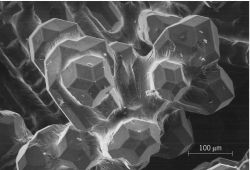Quasicrystal
A solid with conventional crystalline properties but exhibiting a point-group symmetry inconsistent with translational periodicity. Like crystals, quasicrystals display discrete diffraction patterns, crystallize into polyhedral forms, and have long-range orientational order, all of which indicate that their structure is not random. But the unusual symmetry and the finding that the discrete diffraction pattern does not fall on a reciprocal periodic lattice suggest a solid that is quasiperiodic. Their discovery in 1982 contradicted a long-held belief that all crystals would be periodic arrangements of atoms or molecules.
It is easily shown that in two and three dimensions the possible rotations that superimpose an infinitely repeating periodic structure on itself are limited to angles that are 360°/n, where n can be only 1, 2, 3, 4, or 6. Various combinations of these rotations lead to only 32 point groups in three dimensions, and 230 space groups which are combinations of the 14 Bravais lattices that describe the periodic translations with the allowed rotations. Until the 1980s, all known crystals could be classified according to this limited set of symmetries allowed by periodicity. Periodic structures diffract only at discrete angles (Bragg's law) that can be described by a reciprocal lattice, in which the diffraction intensities fall on lattice points that, like all lattices, are by definition periodic, and which has a symmetry closely related to that of the structure. See Crystal, Crystallography, X-ray crystallography, X-ray diffraction
Icosahedral quasicrystals were discovered in 1982 during a study of rapid solidification of molten alloys of aluminum with one or more transition elements, such as manganese, iron, and chromium. Since then, many different alloys of two or more metallic elements have led to quasicrystals with a variety of symmetries and structures. The illustration shows the external polyhedral form of an icosahedral aluminum-copper-iron alloy.
The diffraction patterns of quasicrystals violate several predictions resulting from periodicity. Quasicrystals have been found in which the quantity n is 5, 8, 10, and 12. In addition, most quasicrystals exhibit icosahedral symmetry in which there are six intersecting fivefold rotation axes. Furthermore, in the electron diffraction pattern the diffraction spots do not fall on a (periodic) lattice but on what has been called a quasilattice. See Electron diffraction
